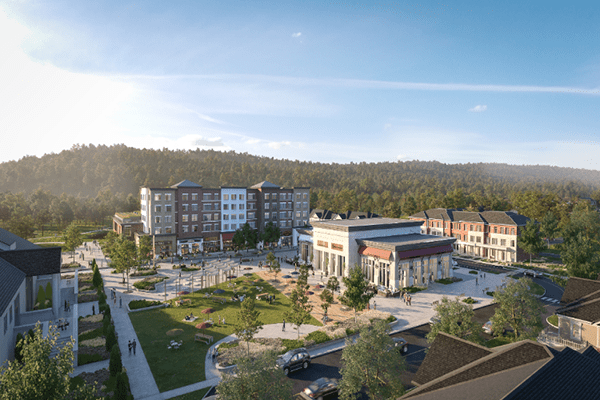|
RCBJ-Audible (Listen For Free)
|
Suit Claims Town Of Ramapo Failed To Take The “Hard Look” Required By SEQRA When It Reviewed And Adopted PUD
The Millers Pond Planned Unit Development (PUD), the first of its kind in the Ramapo’s Northeast Corner, is big. It encompasses 637 residential units with 67,000 square feet of non-residential, mixed use commercial space on 143 acres of land on the former Minisceongo Golf Course in Pomona.
In creating zoning for PUDs, the Town sought to create walkable, less-traffic intensive, pedestrian-friendly neighborhoods.
Last month, neighbors of the planned community sought to derail the development and filed a lawsuit in Rockland County Supreme Court alleging that the adoption of the PUD was illegal. The neighbors are represented by attorney Susan Shapiro of the Nanuet-based Rockland Environmental Group. Shapiro has filed several court challenges against the Town of Ramapo and its land-use boards.
The Millers Pond development plan calls for the residential units to be clustered, and approximately 39 percent of the property will be preserved as open-space. The plan calls for 118 buildings, made up of large manor houses, town houses, and interior roadways, pocket parks, swimming pools, and mixed-use residential and commercial buildings. Primary access will be through Pomona Road. Additional access may be through Camp Hill Road and Station Road.
Existing ponds and wetlands will be preserved, as will a cemetery located on site. Townhome height will be limited to 45 feet and mixed-use building height 60 feet. Extensive walking paths will be preserved and created, as will several new parks on the property.
Environmentally sensitive lands (wetlands, wetland buffers, limited areas of floodplain and open space) adjacent to Rockland County Mt. Ivy Park will be preserved.
The Town of Ramapo approved the rezoning of the property and adopted the Millers Pond PUD in March after more than a year of public hearings, public comments, environmental reviews, comments from other agencies, and consideration of possible adverse environmental impacts and their significance.
Last August, the Town found that the impacts of the environment were not significant and a “Negative Declaration” notice was published by the NYS DEC on September 13, 2023.
On July 15th, a group of neighbors living adjacent to or in close proximity to the Millers Pond PUD filed a lawsuit in Rockland County Supreme Court alleging that the town committed a bevy of illegal acts in approving the PUD, from failing to give adequate notice, failing to publish, and failing to follow the procedural requirement of both SEQRA (State Environmental Quality Review Act) and Ramapo Town law.
The neighbors also complain that the town’s Negative SEQRA declaration was arbitrary, irrational and lacked a legal basis, essentially saying that the town failed to take the necessary “hard look” required by SEQRA when evaluating a project. The complaint also the town engaged in illegal segmentation — breaking up a project into smaller pieces to avoid meaningful environmental review of the entire project.
At one point it their 63-page, 256-paragraph complaint, the neighbors also accuse the town of acting intentionally to hide the project’s details for the purpose of precluding the public from participating in the environmental review process.
At the heart of the complaint, other than alleged procedural failures, is a disagreement over whether the town really considered all the potential impacts and whether the Negative Declaration was justified. The neighbors claim the Negative Declaration was actually an illegal Conditional Negative Declaration – an option not available on what are called Type 1 Actions – generally large projects that require the preparation of multiple levels of environmental assessments.
The neighbors claim the Negative Declaration was made to avoid the preparation of a Draft Environmental Impact Statement, a process that would have enabled extensive public participation and required consideration of alternatives to the pending development plan.
Among the claimed shortfalls in environmental review are effects of high-density housing, visual and lighting impacts, community character, impacts of environmentally sensitive areas, water, sewer, and traffic.
Plaintiffs also claim that certain lots should not have been included in the PUD because they are not contiguous with other lots, and that certain lots not be included for purposes of density calculation because they are not themselves developable.
For relief, Plaintiff’s has asked the Court to annul the decisions of the Ramapo Town Board and remand the application back to the town to take a “hard look” at the impacts through a site-specific environmental impact statement with public participation. They also ask that all neighbors within 500 feet of the Millers Pond property line receive notice of all public hearing on the application.











